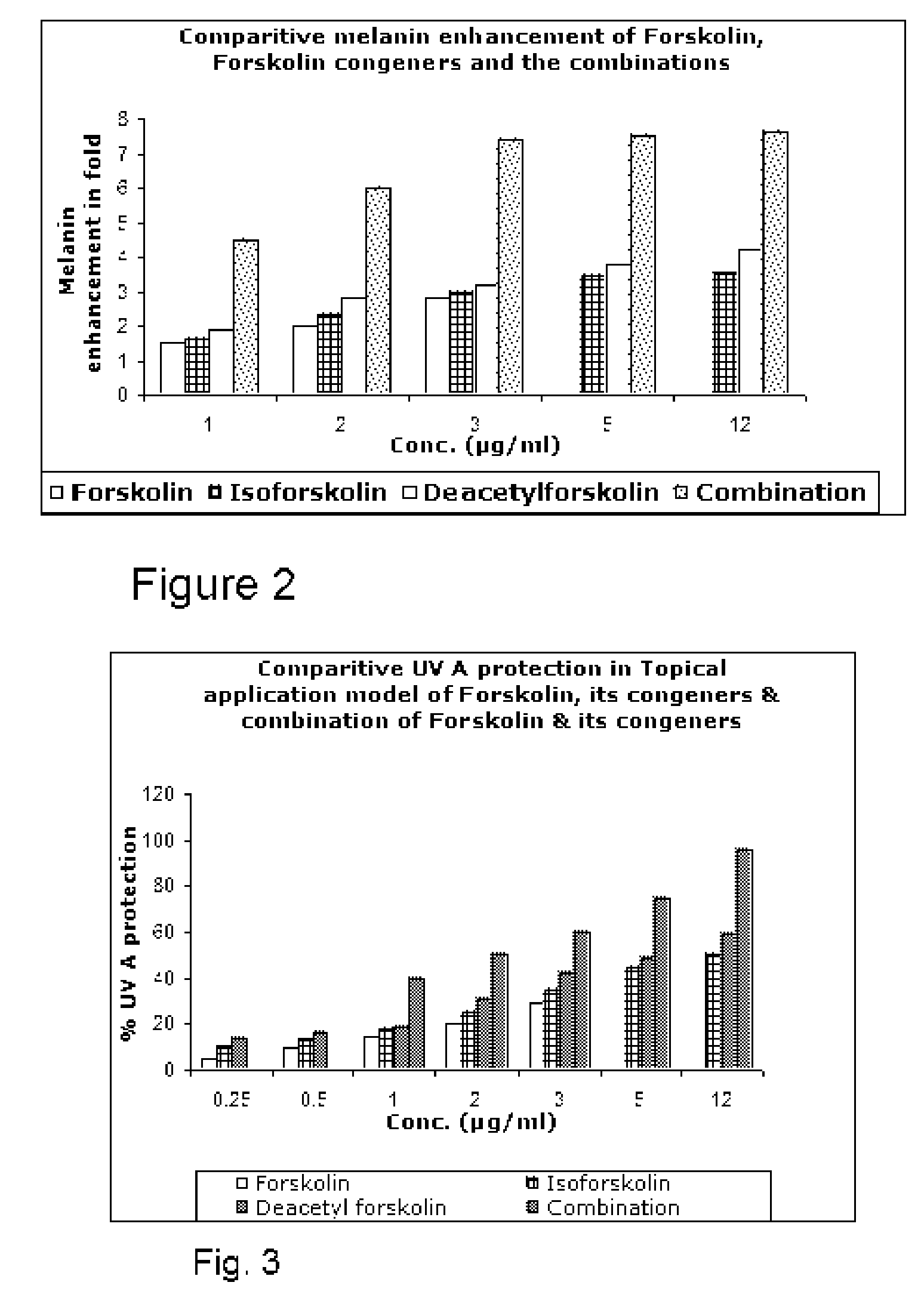Compositions and methods to effect enhanced photoprotection against UV A and UV B induced damage of human skin
a technology of enhanced photoprotection and human skin, which is applied in the field of compositions and methods to achieve enhanced photoprotection against uv a and uv b induced damage of human skin, can solve the problems of skin cancer, uv ray damage to dna, and disorderly manner to become cancerous, and normal skin cells may begin to grow in the uncontrolled manner
- Summary
- Abstract
- Description
- Claims
- Application Information
AI Technical Summary
Benefits of technology
Problems solved by technology
Method used
Image
Examples
example 1
[0075]Table A shows the comparative % UV A protection conferred by combinations of active I, active II and active III in both topical and oral application protocols. Table B shows the comparative % UV B protection conferred by combinations of active I, active II and active III in both topical and oral application protocols. FIG. 1 shows a graphical representation of the comparative UV A protection (%) conferred to HaCaT human keratinocyte cell lines by varying concentrations of active III, congeners of active III (active I and active II) and combinations thereof in a topical application model. FIG. 2 shows a graphical representation of the comparative UV A protection (%) conferred to HaCaT human keratinocyte cell lines by varying concentrations of active III, congeners of active III (active I and active II) and combinations thereof in an oral application model. FIG. 3 shows a graphical representation of the comparative UV B protection (%) conferred to HaCaT human keratinocyte cell l...
example 2
[0076]FIG. 5 shows a graphical representation of the comparative melanin enhancement in fold by varying concentrations of active I, active II and active III in the B16F1 mouse melanoma cells. The same data is also presented in Table C. It is shown that active I enhances intracellular melanin production in B16F1 cells more than active II or active III. Active II and active I still continue to show enhanced efficacy and tolerability even at dose levels 2.4 times the maximum tolerated dose levels of active III.
TABLE CNo. of folds of Melanin EnhancementConcentrationcompared to controlμg / mlActive IIIActive IIActive I0.251 1 1.1 0.51.1 1.1 1.2511.5*1.6*1.9*22* 2.3*2.8*32.8*3* 3.2*5toxic 3.45*3.8*12toxic3.5*4.2**‘t’ test, significance: p Toxic = Toxic to the cells under the test conditions.
example 3
[0077]FIG. 6 shows a graphical representation of the comparative melanin enhancement in fold by varying concentrations of active III, congeners of active III (active I and active II) and combinations thereof in B16F1 mouse melanoma cells. The same data is also presented in Table D. The combination of actives I, II and III at a concentration of 5 μg / ml and 12 μg / ml result in an optimal point for melanin enhancement.
TABLE DConcentration (μg / ml)MelaninActive IIIActive IIActive ICombinationenhancement0.50.250.2514.5*10.50.526* 11137.4*12257.5*255127.6**‘t’ test, significance: p
PUM
| Property | Measurement | Unit |
|---|---|---|
| Capacitance | aaaaa | aaaaa |
| Fraction | aaaaa | aaaaa |
| Fraction | aaaaa | aaaaa |
Abstract
Description
Claims
Application Information
 Login to View More
Login to View More - R&D
- Intellectual Property
- Life Sciences
- Materials
- Tech Scout
- Unparalleled Data Quality
- Higher Quality Content
- 60% Fewer Hallucinations
Browse by: Latest US Patents, China's latest patents, Technical Efficacy Thesaurus, Application Domain, Technology Topic, Popular Technical Reports.
© 2025 PatSnap. All rights reserved.Legal|Privacy policy|Modern Slavery Act Transparency Statement|Sitemap|About US| Contact US: help@patsnap.com



